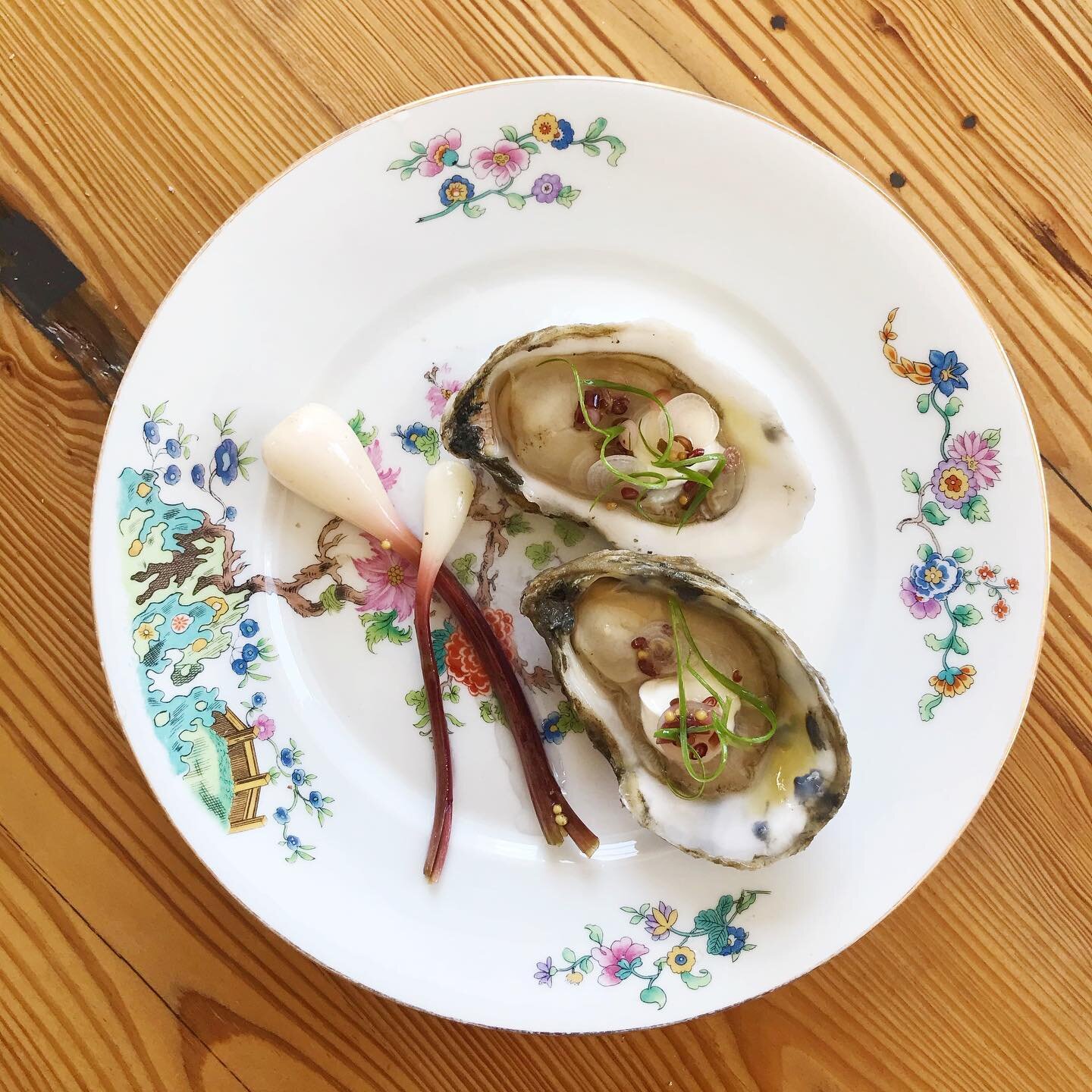Oysters
There are over 200 species of oysters in the world, but only a few species are commonly used for food. The edible varieties are usually cultivated in approved coastal waters that are closely monitored to assure product safety. These extra measures for product safety are necessary because many consumers prefer to eat raw oysters. However, as you can see below, there are many ways to enjoy oysters besides eating them raw—including baking and grilling them!
Delaware Sea Grant has long been focused on oyster growth, health, and promotion. We fund research on commercial-scale aquaculture, sustainable seafood, and seafood handling technology to keep our state's fishing industry at the leading edge of economic development and environmental responsibility. We’re also working with fishermen, state regulators, and citizens to explore promising new economic drivers in aquaculture.
For a list of more seafood options and their suppliers, visit our directory.
Oysters with Mignonette
Recipe courtesy of Matt Kern, Executive Chef at Heirloom in Lewes, Delaware
Ramp Mignonette
About a pound of ramps (cleaned and trimmed)
1 cup rice wine vinegar
3/4 cup sugar
1/2 cup water
1 tsp. mustard seed
1/2 tsp. Chinese 5 spice
Pinch of kosher salt
Preparation:
1. In a small sauce pot, combine vinegar, sugar, water, mustard seed, 5 spice and salt and bring to a simmer. Take off heat and directly pour over cleaned ramps in a heat safe container.
2. Refrigerate until needed.
Creme Fraiche
1/2 cup heavy whipping cream
1/2 cup sour cream
Juice of 1 lemon
Pinch of kosher salt
Preparation:
1. Mix all ingredients on list with a whisk
2. Place in a sealed container in refrigerator for at least 24 hours before using.
To assemble oysters:
1. Lightly scrub any loose dirt from oysters with cold water and a brush.
2. Carefully shuck oysters and place on crushed ice.
3. Slice a pickled ramp thinly and place a few slices with a few drops of pickle juice directly on oysters.
4. Place a tiny dab of creme fraiche on next and finish with a few slices of scallion for color.
5. Serve right away and enjoy.
Contest winner: Coby Grandma’s Scalloped Oysters
Recipe courtesy of Diane Hernady. Serves 6.
Ingredients
1 pint stewing oysters, drained (reserve liquid)
2 cups cracker crumbs, such a saltines, or other medium weight cracker
1/2 cup butter, melted
Salt and pepper, to taste
3/4 cup light cream
1/4 cup reserved oyster liquid
1/4 teaspoon Worcestershire sauce
Preheat oven to 350 degree. Spread 1/3 of cracker crumbs into greased 9x9 inch baking dish. Cover with 1/2 of the oysters. Season with salt and pepper. Repeat layers. Combine cream, oyster liquid and Worcestershire sauce and pour over oysters. Top with final 1/3 of cracker crumbs. Bake at 350* for 40 mins. then serve.
Oyster Sliders
Recipe courtesy of Matt Kern, Executive Chef at Heirloom in Lewes, Delaware
Ingredients
1 tbsp. Duke’s mayonnaise
Dash of hot sauce (optional)
Pickled onion (just a few)
Parker House rolls or King’s Hawaiian rolls
1/2 cup panko bread crumbs
1/2 cup all-purpose flour
3 eggs (lightly beaten)
Kosher salt
4-5 Tower 3 Oysters (shucked and drained)
4 cups of neutral oil for frying (peanut oil or a substitute).
Recipe Preparation
Prepare 3 bowls as a breading station: flour, then egg wash, and lastly panko. Dredge oysters thoroughly in flour, transfer to egg wash, and then to the bread crumbs making sure to coat all the oysters evenly. Set aside until ready to fry.
Bring 4 cups of oil to 340 degrees in a Dutch oven or thick bottom pot using a thermometer. Carefully drop breaded oysters into oil with a spoon making sure not to splash. Fry for 4 minutes and check to make sure coating is golden brown. Remove oysters from oil with tongs and transfer to a paper towel to drain. Season immediately with a few flakes of kosher salt and let stand.
Start assembling your sliders with a little more Duke’s mayonnaise, a dash of hot sauce (optional), and a few pickled onions. Add you’re perfectly fried oysters and SHOVE YOUR FRESHLY ASSEMBLED MASTERPIECE DIRECTLY IN TO YOUR MOUTH!
Oysters Asiago
Recipe courtesy of Mike Love, Executive Chef at the Lewes Yacht Club in Lewes, DE
Oysters Asiago infuses the components of a creamy seafood chowder with bold italian flavors into a delicious filling even the staunchest oyster-haters will have a hard time resisting.
Ingredients
One dozen large oysters (Delaware Bay oysters courtesy of Fred and Tim Sage are perfect for this)
½ of an onion, chopped
1 stalk of celery, chopped
1 clove of garlic minced
A handful of spinach (I have never measured this part and refuse to start now)
4oz of slab bacon, diced (bacon slices cut into small pieces work just as well)
Italian seasoning, optional
A splash of marsala wine
1 cup heavy cream
5oz asiago cheese
1 russet potato, diced small
First we need to shuck the oysters. This can be intimidating for the uninitiated, so I’ll give a quick tutorial. If you have soft hands you might want to put on some gloves. Give the oysters a thorough wash and scrub (they live in dirt after all). Now grab an oyster with a kitchen towel with the hinge side out, concave side down. Set your oyster knife into the hinge and find an area where you can pry without breaking away pieces of the shell. Sometimes a little force is required to find the sweet spot. When you hear the initial pop, the hard part is done. Run the knife around the edge, keeping it level as best as you can with the flat side of the shell. When you remove the flat side of the shell, run your knife along the underside of the oyster to disconnect the meat from the shell.
Okay, let’s get set up. Preheat an oven to 425 F, set a small pot of salted water on the stove to boil, and heat a large skillet on low as you prep the ingredients. Chop your onion and celery, mince your garlic, dice your bacon, and dice the potato. By now your water is probably boiling and your skillet hot but not blazing (unless you chop slowly, in which case your house might be on fire by now). Blanch the potatoes in the water for 5 minutes or until tender, drain and set aside. Add the bacon to the skillet, allowing it to brown and render its fat. Add the onion, celery, and garlic and let it all sweat. When the onions have that sweet, translucent look add the Italian spice if you're using it and allow it to cook for just a second before deglazing with the marsala.
Let’s talk about that just for a second because A. saying Italian spice makes me sound like a chump and B. you probably don’t allaws have a bottle of marsala in your kitchen and you don’t feel like getting any. I like to make my own Italian spice using dry thyme, dry rosemary, dry oregano, celery seed, fennel seed, sesame seed, whole black peppercorns, and a pinch of chili flake. Through it all in the blender and pulse until fine. Make a big batch and keep it in an airtight container; it’s good for seasoning meats, sauces, dressing, soups, anything to which you want to add a touch of Italy (please don’t sue me Touch of Italy). On the subject of wine, I like to use marsala to keep with the italian flavors in this dish, but cream sherry, dry vermouth, or any bright acidic white wine will work just as well. Now let’s get back to the action.
When most of the liquid from the wine has evaporated add the heavy cream and reduce the heat. Allow the cream to reduce a bit and stir in the spinach. When the spinach is wilted kill the heat and fold in most of the asiago (reserving some for topping the oysters) and boiled potatoes. Taste and adjust with salt, and a splash of vinegar or lemon juice if you want a little more acid.
Arrange your oysters on a baking sheet and fill each one with a generous scoop of the filling. There might be some left depending on the size of your oysters. Eat it noisily over a trash can or sink for an authentic chef experience. Top the stuffed oysters with the remaining asiago and bake until gooey and delicious. Allow to cool for a few minutes before digging in (unless you don’t want to taste anything for the next week, seriously they come out super hot). Serve with lemon wedges and tobasco (that’s a good rule of thumb for any oyster dish), and enjoy.
Watch out for stowaways!
Grilled Oysters: The Ed Hale Method
Method courtesy of Ed Hale, DESG Marine Advisory Specialist.
Preparation
Before cooking, discard any shellfish with open shells. Only eat shellfish that open during cooking. Scrub exterior of oysters with brush in sink to remove loose debris if not cleaned already.
Grilling
Set the oysters with cupped side down on the cooking grate. Cover the grill, and cook oysters on medium-medium high heat until their shells have cracked open and the meat is opaque. Time necessary will vary based on oyster size, with larger oysters needing more time. 5 minutes is a good place to start checking for opened oysters.*
Serving
Remove oysters which have opened with a set of tongs and pry the two hinges apart. Oysters don’t open as widely as clams do, so if you can fit a knife or the tongs into an oyster shell, it is considered open. Continue cooking oysters that have not opened.
Oysters are delicious with or without garnishes. If desired, garnish with fresh lemon juice, minced garlic, or pesto sauce
*Note: Most seafood is recommended to reach an internal temperature of 145 degrees. The CDC recommends baking oysters at 450 degrees for 10 minutes or broiling them 3” from heat for 3 minutes.








